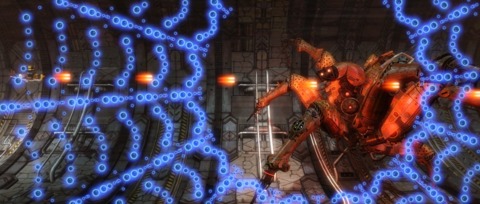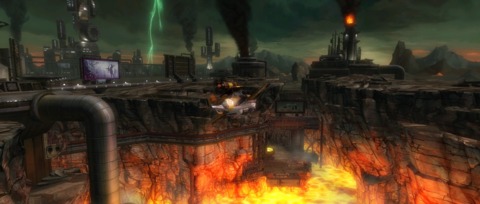
The sort of tough-as-nails retro gameplay you associate with the phrase "bullet hell" is usually the domain of obscure homebrewed PC projects spawning from lone developers in Japanese basements, but Xbox Live Arcade's new shooter Sine Mora goes the extra mile, marrying wonderful mainstream production values to its endless onslaught of side-scrolling enemies. Maybe it's no surprise that such an offbeat project sprang from the rogue developers at Suda 51's Grasshopper Manufacture, which contributed art and sound design to the production otherwise handled by Hungarian developer Digital Reality. The result is one of the most original arcade-style action games to come along in a while, but one that stumbles a bit when the rubber meets the road... er, the ship meets the air? You know, the part where you play it.
The length of Sine Mora certainly harkens back to the days of R-Type and Gradius, since the story mode will only last you around 90 minutes, and that's counting the surprisingly lengthy cutscenes. Even more surprising is the game's adult tone and subject matter, which primarily deals with total warfare and ethnic cleansing, and features such downtrodden figures as a father grimly focused on avenging his son's murder, and a female pilot who survives a rape only to be blackmailed into fighting for a cause she cares nothing about. Also, all the characters are animal people of various, unrelated types. Also, there's time travel? I'd sum all this up more succinctly if the game's storyline were easier to follow, but each chapter jumps so disjointedly between locations, time periods, events and characters (who merely exist as static portraits with voiceover) that the broad narrative doesn't really start to cohere until the very end of the game. Until then, it's hard to form a clear picture of exactly what's going on, and what seems like a promising storyline--a rarity in itself for this genre--ends up falling a little flat.

Sine Mora has some interesting high-level mechanics layered on top of all the flying to the right and shooting, most of which--in keeping with the storyline--focus on time. Second only to dodging and shooting everything around you, your most important concern is to keep an eye on a timer that's constantly ticking down at the top of the screen, because as soon as that timer runs out, you die. Every enemy you kill increments the timer, so killing as much stuff as possible is key to staying alive. You can't die just by being hit by something (with a few annoying exceptions), but every hit shaves precious seconds off that clock, so it's just as important to avoid trouble as it is to take out enemies. You also have a limited ability to slow down time at will, which naturally helps you do both of those things. Most of the game is designed in such a way that you can maneuver through the onslaught of enemies and bullets with quick reflexes and deft use of the time ability, but there are too many occasions, almost all in boss fights, that hit you with some unavoidable instant-death attack that you can't realistically dodge if you don't know it's coming. Those moments pretty much force you to memorize them if you want to get through unscathed.
The game offers an appropriate slew of other power-ups that give you a shield, let you use a pilot-specific super weapon, and--most importantly--dramatically increase the power of your main gun. That's where the gameplay broke down for me. At default gun power, even the weakest enemies take a few shots to kill, though with something like 10 upgrade levels for that gun, you can lay waste to everything in sight once you power it up sufficiently. Since your ability to kill a lot of enemies and add to your timer is absolutely crucial to keeping you alive, you want to get those upgrades up as fast as you can. Taking a single hit causes all of your upgrades to fly out of your ship and drift around aimlessly, though, and if that happens in the middle of a hectic hail of bullets, you can just about give up on getting all (or in some cases any) of them back without taking more hits, which will deplete your spare time real fast. That feels a little like a catch-22. If you have to hang back and let those power-ups float away, your firepower is often so diminished that you don't have much hope of killing enough enemies to keep your time up until the next checkpoint. More often than I would have liked, this creates a negative feedback loop where doing poorly diminishes your subsequent ability to improve your performance, almost guaranteeing you'll do even more poorly in the remaining few seconds before you die. Sine Mora has a sound framework and I was more than ready to submit to its retro brutality, but the downward-spiraling weapon system coupled with the memorization-heavy bosses and some occasional nonsensical bullet patterns often made the game feel frustrating in the wrong way.

If you're the sort of casual player who might play through this game once and be done with it, the 90-minute story is a hard sell at the $15 price. But those who identify with terms like "1CC" and "superplay," or even slightly less committed shooter fans who just want to chase a few high scores, will find plenty of extra stuff to spend time on. Arcade mode offers the full sequence of levels in one long, unbroken run sans cutscenes, though it's a shame that this mode's lowest difficulty is hard, which is... really hard. On the upside, you can mix and match ships and pilots to get different basic and special attack combos, and optionally swap out the time dilation power for a brief rewind or a bullet-reflect shield. Boss training and score attack modes offer other ways to dig into the action piecemeal, and even higher difficulty levels present a truly ludicrous degree of challenge for the hardest of core. The game even embeds a long list of individual challenges into each achievement, so if you really wanted to do everything in this game, it would probably take you ages.
Seeing the amount of careful thought the developers lavished on every aspect of Sine Mora's design continually made me wish that the core action had clicked more solidly for me. The game looks marvelous, and it's an impressive effort in this little-seen genre, but the gameplay is wrapped too rigidly around mechanics that feel a bit at odds with one another for me to feel good recommending it wholeheartedly.